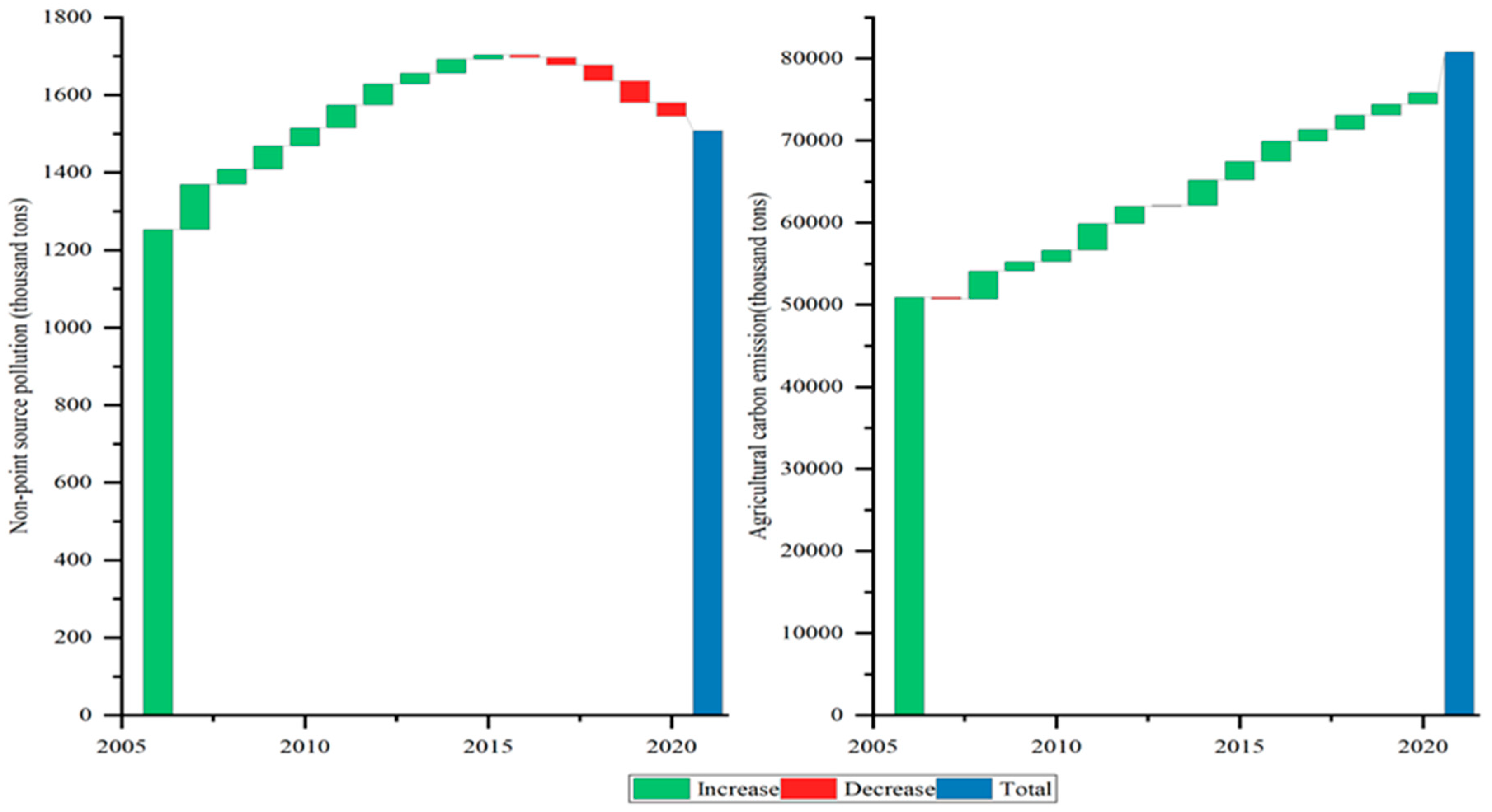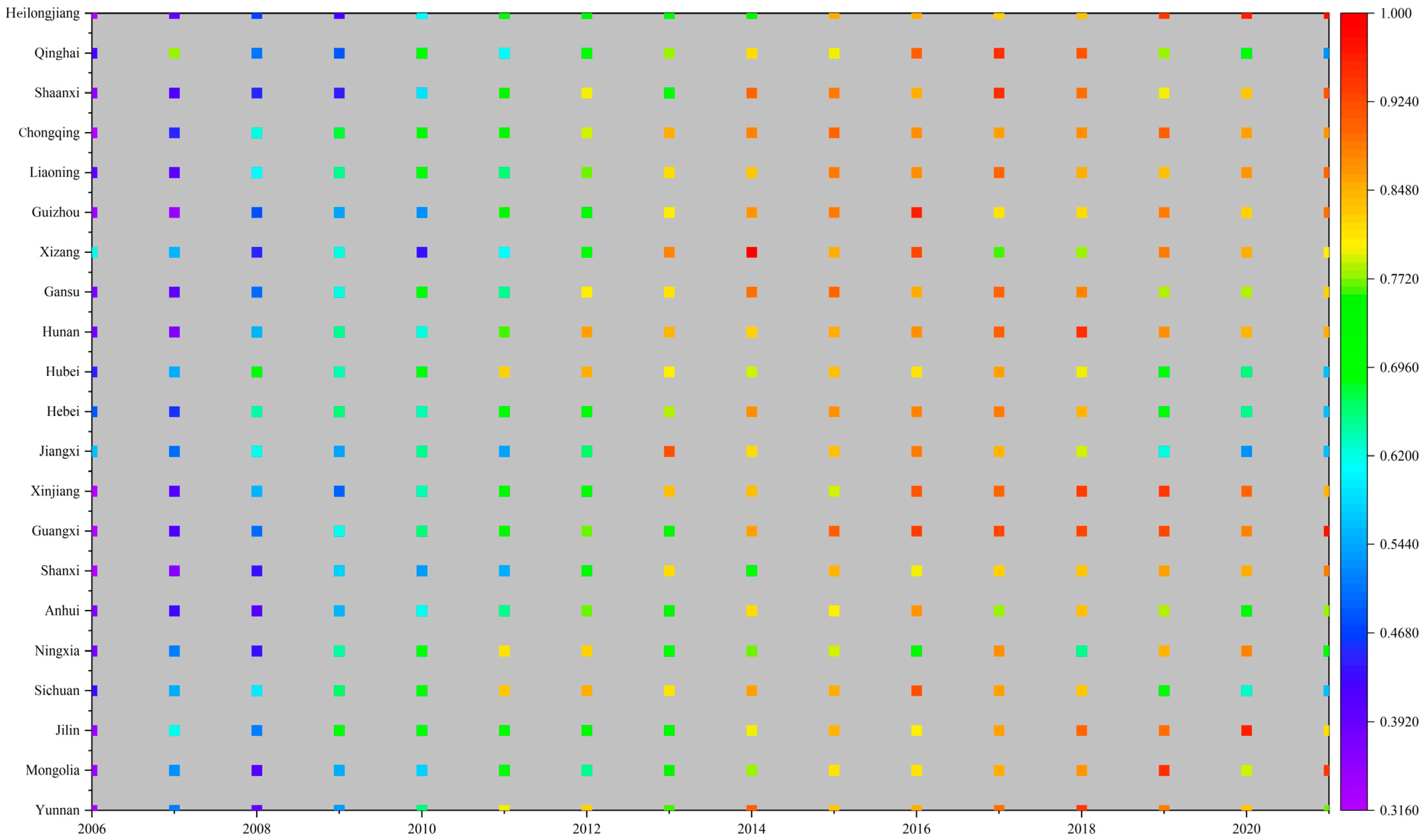Spatial–Temporal and Decoupling Effect of Agricultural Carbon Pollution Synergy in Ecologically Fragile Areas
Abstract
1. Introduction
2. Materials and Methods
2.1. Methods
2.1.1. Measurement of Agricultural Carbon Emissions
2.1.2. Measurement of Agricultural Non-Point Source Pollution
2.1.3. Coupling Coordination Model
2.1.4. Tapio Decoupling Model
2.2. Data
3. Results
3.1. Synergistic of Agricultural Carbon Pollution in Ecologically Fragile Areas
3.2. Spatial and Temporal Characteristics in Different Provinces
3.3. Synergistic Decoupling of Agricultural Carbon Pollution
4. Discussion
5. Conclusions
Author Contributions
Funding
Data Availability Statement
Acknowledgments
Conflicts of Interest
References
- Hou, M.; Cui, X.; Xie, Y.; Lu, W.; Xi, Z. Synergistic emission reduction effect of pollution and carbon in China’s agricultural sector: Regional differences, dominant factors, and their spatial-temporal heterogeneity. Environ. Impact Assess. Rev. 2024, 106, 107543. [Google Scholar] [CrossRef]
- Huang, X.; Fahad, S.; Yang, F.; Nie, F. Fiscal policy, green finance, and low carbon transformation nexus: A novel study unleashing the synergistic effects of carbon reduction and pollution in China. Environ. Sci. Pollut. Res. 2023, 31, 4256–4268. [Google Scholar] [CrossRef]
- Yan, X.; Sun, Q. How to Evaluate Ecological Civilization Construction and Its Regional Differences: Evidence from China. Sustainability 2023, 15, 12543. [Google Scholar] [CrossRef]
- Tang, J.; Li, S. Research on multiple co-governance of agricultural non-point source pollution in China on the perspective of ENGOs and public participation. PLoS ONE 2023, 18, e0280360. [Google Scholar] [CrossRef] [PubMed]
- Zhou, Y. Editorial: China’s economic growth in a global context: Challenges and opportunities and future research. J. Chin. Econ. Foreign Trade Stud. 2024, 17, 1–3. [Google Scholar] [CrossRef]
- Li, X.; He, Y.; Fu, Y.; Wang, Y. Analysis of the carbon effect of high-standard basic farmland based on the whole life cycle. Sci. Rep. 2024, 14, 3361. [Google Scholar] [CrossRef] [PubMed]
- Yang, Y.; Xu, H.; Yang, X.; Zhang, Y.; Liu, T. Exploring synergistic efficiency of air pollution and carbon reduction and its influencing factors: Insights from China. Resour. Conserv. Recycl. 2024, 212, 107973. [Google Scholar] [CrossRef]
- Nie, C.; Lee, C.C. Synergy of pollution control and carbon reduction in China: Spatial–temporal characteristics, regional differences, and convergence. Environ. Impact Assess. Rev. 2023, 101, 107110. [Google Scholar] [CrossRef]
- Nazia, L. Comprehensive environmental performance index (CEPI): An intuitive indicator to evaluate the environmental quality over time. Environ. Res. Commun. 2022, 4, 075016. [Google Scholar] [CrossRef]
- Liu, C.; Sun, W.; Li, P. Characteristics of spatiotemporal variations in coupling coordination between integrated carbon emission and sequestration index: A case study of the Yangtze River Delta. China Ecol. Indic. 2022, 135, 108520. [Google Scholar] [CrossRef]
- Ullah, S.; Lin, B.; Zhu, R. Developing a new sustainable policy perspective for Pakistan: An intricate nexus between green innovation, financial structure and ecological footprint. Energy 2025, 316, 134496. [Google Scholar] [CrossRef]
- Pan, X.; Guo, S. Dynamic decomposition and regional differences of urban emergy ecological footprint in the Yangtze River Delta. J. Environ. Manag. 2023, 326, 116698. [Google Scholar] [CrossRef]
- Ehigiamusoe, K.U.; Chen, D.; Dogan, E.; Binsaeed, R.H. Unravelling the moderating roles of environmental regulations on the impact of foreign direct investment on environmental sustainability. J. Environ. Manag. 2025, 375, 124175. [Google Scholar] [CrossRef] [PubMed]
- Wen, H.; Liang, W.; Lee, C.C. China’s progress toward sustainable development in pursuit of carbon neutrality: Regional differences and dynamic evolution. Environ. Impact Assess. Rev. 2023, 98, 106959. [Google Scholar] [CrossRef]
- Chen, F.; Zhao, T.; Wang, D. Research on China cities’ total factor productivity of carbon emission: Based on decoupling effect. Int. J. Environ. Res. Public Health 2022, 19, 2007. [Google Scholar] [CrossRef]
- Haiyan, S.; Shangmiao, S. Impact of green innovation on carbon reduction in China. Sci. Rep. 2024, 14, 14032. [Google Scholar]
- Dong, J.; Qiao, D.; Yuan, B.; Xu, T. Total factor productivity of China’s marine economy: A meta-analysis. Front. Mar. Sci. 2022, 9, 1014112. [Google Scholar] [CrossRef]
- He, Y.; Zhang, X.; Xie, Q. Environmental regulation and carbon emission efficiency: Evidence from pollution levy standards adjustment in China. PLoS ONE 2024, 19, e0296642. [Google Scholar] [CrossRef] [PubMed]
- Yan, Y.; Chen, Y.; Han, M.; Zhen, H. Research on energy efficiency evaluation of provinces along the belt and road under carbon emission constraints: Based on super-efficient SBM and Malmquist index Model. Sustainability 2022, 14, 8453. [Google Scholar] [CrossRef]
- Wang, K.; Fang, C. Revealing the synergy between carbon reduction and pollution control in the process of new-type urbanization: Evidence from China’s five major urban agglomerations. Sustain. Cities Soc. 2025, 120, 106154. [Google Scholar] [CrossRef]
- Chen, L.; Wang, D.; Shi, R. Can China’s carbon emissions trading system achieve the synergistic effect of carbon reduction and pollution control? Int. J. Environ. Res. Public Health 2022, 19, 8932. [Google Scholar] [CrossRef]
- Zhang, X.; Wei, Y.; Wang, T.; Shen, J.; Zhao, T.; Dong, L. Spatial correlation network on synergy between carbon reduction and pollution control in key areas for air pollution prevent and control. J. Clean. Prod. 2025, 491, 144777. [Google Scholar] [CrossRef]
- Lujing, W.; Ming, Z. Exploring the impact of narrowing urban-rural income gap on carbon emission reduction and pollution control. PLoS ONE 2021, 16, e0259390. [Google Scholar]
- Xu, L.; Peng, S.; Wang, L. The Synergy of Pollution and Carbon Reduction by Green Fiscal Policy: A Quasi-Natural Experiment Utilizing a Pilot Program from China’s Comprehensive Demonstration Cities of Energy Conservation and Emission Reduction Fiscal Policy. Sustainability 2025, 17, 667. [Google Scholar] [CrossRef]
- Wang, G.; Liu, P.; Hu, J.; Zhang, F. Spatiotemporal Patterns and Influencing Factors of Agriculture Methane Emissions in China. Agriculture 2022, 12, 1573. [Google Scholar] [CrossRef]
- Climate Change 2013: The Physicle Science Basis Technical Summary; IPCC: Geneva, Switzerland, 2013.
- Ma, T. Assessment of the current status of agricultural carbon sources and analysis of the potential for increasing carbon sinks in Shanghai. Sustain. Dev. 2011, 28, 38–41. [Google Scholar]
- Wang, B.; Zhang, W. Study on the Measurement of Agroecological Efficiency and Spatial and Temporal Differences in China. China Popul.-Resour. Environ. 2016, 26, 11–19. [Google Scholar]
- Duan, H.P.; Zhang, Y.; Zhao, J.B.; Bian, X. Carbon footprint analysis of farmland ecosystems in China. J. Soil Water Conserv. 2011, 25, 203–208. [Google Scholar]
- Li, B.; Zhang, J. Study on decoupling agricultural carbon emissions and economic development in China based on input perspective. Econ. Econ. 2012, 27–31. [Google Scholar]
- Wang, R.; Chen, J.; Li, M. Coupling and Coordinating Relationship between Agricultural Eco-Efficiency and Food Security System in China. Int. J. Environ. Res. Public Health 2023, 20, 431. [Google Scholar] [CrossRef] [PubMed]
- Yuan, R.; Xu, C.; Kong, F. Decoupling agriculture pollution and carbon reduction from economic growth in the Yangtze River Delta, China. PLoS ONE 2023, 18, e0280268. [Google Scholar] [CrossRef]
- Li, J.; Jiang, Q. Rural Inclusive Finance and Agricultural Carbon Reduction: Evidence from China. J. Knowl. Econ. 2024, 1–24. [Google Scholar] [CrossRef]
- Zhao, Y.; Wang, J.; Ma, X.; Yao, K. Distribution dynamics, spatial differences, and convergence of synergistic pollution and carbon reduction in China. Environ. Sci. Pollut. Res. Int. 2024, 31, 66911–66937. [Google Scholar] [CrossRef]




| Carbon Source | Carbon Emission Coefficient | Reference Sources |
|---|---|---|
| Diesel fuel | 0.59 kg/kg | IPCC 2013 [26] |
| Chemical fertilizer | 0.89 kg/kg | Oak Ridge National Laboratory, Oak Ridge, TN, USA [27] |
| Pesticide | 4.93 kg/kg | Oak Ridge National Laboratory, Oak Ridge, TN, USA [27] |
| Plastic sheeting | 5.18 kg/kg | Institute of Agricultural Resources and Ecological Environment, Nanjing Agricultural University [28] |
| Irrigation | 266.48 kg/hm2 | [29] |
| Plowing | 312.60 kg/km2 | [30] |
| Pollution Sources | Contaminated Units | Measurement Method |
|---|---|---|
| Fertilizer application in farmland | Nitrogen fertilizer, phosphate fertilizer, and compound fertilizer | Total nitrogen emissions = (net amount of nitrogen fertilizer + net amount of compound fertilizer × 15%) × nitrogen loss coefficient |
| Total phosphorus emissions = (net amount of phosphate fertilizer + net amount of compound fertilizer × 15%) × 43.66% × phosphorus loss coefficient | ||
| Pesticide | pesticide | Pesticide application rate× average loss coefficient (runoff + leaching) |
| Solid waste from farmland | Rice, wheat, vegetables, beans, oilseeds, potatoes, corn, etc. | Crop/vegetable yield× proportion of waste part to grain part × pollution content of waste part × loss rate of waste part |
| Type of Decoupling | Decoupling Relationship | Synergy of Pollution Control and Carbon Reduction | Change in Gross Agricultural Output | Decoupling Elasticity Index | Significance |
|---|---|---|---|---|---|
| Decoupling | Weak decoupling | >0 | >0 | 0 ≤ e < 0.8 | Economic growth, pollution, and carbon reduction capacity have been enhanced, and the growth rate of the latter is lower than the growth rate of the former. |
| Strong decoupling | <0 | >0 | e < 0 | The ability to reduce pollution and carbon emissions has declined, and economic growth has increased. | |
| Recession decoupling | <0 | <0 | e > 1.2 | The ability to reduce pollution and carbon emissions is weakened, and the economy is in recession, and the former is faster than the latter. | |
| Negative decoupling | Expansion negative decoupling | >0 | >0 | e > 1.2 | The ability to reduce pollution and carbon emissions has been enhanced, and the economic growth rate of the former is greater than that of the latter. |
| Strong negative decoupling | >0 | <0 | e < 0 | The ability to reduce pollution and carbon emissions has been enhanced, and the economy has declined. | |
| Weak negative decoupling | <0 | <0 | 0 ≤ e < 0.8 | The ability to reduce pollution and carbon emissions is weakened, and the economy is declining, and the former is slower than the latter. | |
| connect | Expand the connection | >0 | >0 | 0.8 ≤ e ≤ 1.2 | Economic growth, increased capacity to reduce pollution and carbon emissions, and the two are at the same rate. |
| Decay connection | <0 | <0 | 0.8 ≤ e ≤ 1.2 | The economy is decreasing, and the ability to reduce pollution and carbon emissions is decreasing, and the speed of the two is comparable. |
Disclaimer/Publisher’s Note: The statements, opinions and data contained in all publications are solely those of the individual author(s) and contributor(s) and not of MDPI and/or the editor(s). MDPI and/or the editor(s) disclaim responsibility for any injury to people or property resulting from any ideas, methods, instructions or products referred to in the content. |
© 2025 by the authors. Licensee MDPI, Basel, Switzerland. This article is an open access article distributed under the terms and conditions of the Creative Commons Attribution (CC BY) license (https://creativecommons.org/licenses/by/4.0/).
Share and Cite
Wang, G.; Gao, M.; Tang, Y.; Zhao, B. Spatial–Temporal and Decoupling Effect of Agricultural Carbon Pollution Synergy in Ecologically Fragile Areas. Agriculture 2025, 15, 592. https://doi.org/10.3390/agriculture15060592
Wang G, Gao M, Tang Y, Zhao B. Spatial–Temporal and Decoupling Effect of Agricultural Carbon Pollution Synergy in Ecologically Fragile Areas. Agriculture. 2025; 15(6):592. https://doi.org/10.3390/agriculture15060592
Chicago/Turabian StyleWang, Guofeng, Mingyan Gao, Yudai Tang, and Baohui Zhao. 2025. "Spatial–Temporal and Decoupling Effect of Agricultural Carbon Pollution Synergy in Ecologically Fragile Areas" Agriculture 15, no. 6: 592. https://doi.org/10.3390/agriculture15060592
APA StyleWang, G., Gao, M., Tang, Y., & Zhao, B. (2025). Spatial–Temporal and Decoupling Effect of Agricultural Carbon Pollution Synergy in Ecologically Fragile Areas. Agriculture, 15(6), 592. https://doi.org/10.3390/agriculture15060592





